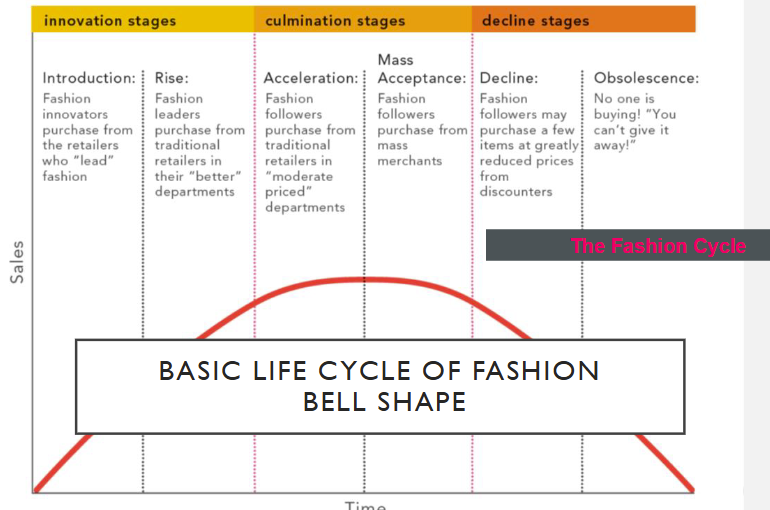Fundamentals of Fashion Merchandising Notes
1/33
There's no tags or description
Looks like no tags are added yet.
Name | Mastery | Learn | Test | Matching | Spaced |
|---|
No study sessions yet.
34 Terms
Fashion
The style/styles of clothing and accessories worn at a particular time by a particular group of people
Style that has been accepted by most people at a given time - result of social acceptance, appeals to many groups
Fashion is a symbolic product
Not every style is a fashion
2 Types of groups that accept fashions
High fashion and mass (volume) fashion
Represents zeitgeist: defining spirit/mood of a particular period in history as shown by the ideas/beliefs of the time
6 “R”s of Fashion Merchandising
At the Right Place
At the Right Time
In the Right Quantities
At the Right Prices
With the Right Sales Promotion
For the Right Target Customer
At the Right Place
The right companies
At the right time
Not too early, not too late
Is this still trendy/will it be trendy soon
At the right prices
Don’t have to mark things down
With the right sales promotion
You know where to market
Don’t market on Tiktok for boomers!
Misconceptions of Fashion
Designers and Retailers dictate what the fashion will be and force it on vulnerable consumers
Reality: Consumers are “variety vultures”
Fashion acts as an influence on women only
Fashion is a mysterious and unpredictable force
Style
Characteristic or unique appearance of a garment
Distinctive artistic expression/presentation
E(g): men’s blazer, aviator, rain jacket
Come and go in acceptance, but once a style always a style
Marilyn Monroe’s white halter, J Lo’s plunging neckline
Usually a creation by an artist or designer
An aesthetic
Design
Interpretation of a style (in the detail)
Version, treatment of a style
A sweatshirt is a style, but it exists in various designs
Low neckline, with pockets, etc
Described by Style Number in the industry
Taste
The prevailing opinion of what is and what is not stylish and appropriate for a specific occasion (timing is key)
Good Taste
Only considered to be worn by people whom it looks appropriate, and in the right timing of the fashion cycle
Classic
Styles/designs that satisfy a basic need over an extensive period of time
Described by simplistic design that isn’t easily outdated
Oxford button-down shirt, blazers, denim, cardigan
Fad
Fad: fashion that sweeps in and out of popularity with a specific group of population usually in one season
Described by exaggerated feature/detail
Usually begins in lower price range
Miniature fashions
Popularity increases, acceptance decreases, decline
Follows same cycle as fashions but much faster
Fads that become fashions: chemise dress
Trend
General direction of movement of a fashion
A few leading designers are showing a certain fashion
Leading retailers are buying
Fashion forward customers are buying
Identify trend from fad?
Who’s doing it?
Fad is usually just mass-market
Trend is opposite
Can be hard to differentiate
4 Elements of fashion design
Silhouette
Details
Texture
Color
Silhouette
Shape/form, overall outline of a garment
Bell-shaped, bouffant
Bustle or back fullness
Straight/tubular
Variations on tubular include slim, rectangular, a-line
Evolve gradually through changes in detail
Details
Individual elements that define silhouette, give its form/shape
Trimmings
Skirt and pant length
Shoulder, waist, and sleeve treatment
When a trend of detail reaches a peak/extreme, it will see a reversal
Suit Trends: 40s-50s, wide shoulders and pads
60s-70s, casual and unstructured
Texture
The look and feel of a material
Woven, knitted, or non-woven
Influences drape and color
Color
Is the key factor in apparel selection for both sexes
Symbolism
The 4 color families
Naturals
Pastels
Darks
Bright
Warm vs Cool
Natural Colors
Colors derived from the sky, landscape, and water
Pastels
Colors lightened with white
Darks
Tones and shades of colors
Bright Colors
High intensity colors
When clothes are more colorful, people wear fewer accessories

Fashion Cycle
5 Stages
Innovation
Introduction (indecent/shameless)
Rise (outre)
Culmination (smart)
Acceleration
Mass Acceptance
Decline Stages
Decline (dowdy, hideous)
Obsolescence (ridiculous)
Introduction
Fashion innovators purchase from the retailers that “lead” fashion
Rise
Fashion leaders purchase from traditional retailers in their “better” departments
Culmination
Fashion followers purchase from traditional retailers in “moderately priced” departments
Fashion followers purchase from mass merchants
Decline
Fashion followers may purchase a few items at greatly reduced prices from discounters
Obsolescence
No one is buying!!!!!!!!!!!!
Variations in the Fashion Cycle
Lengths of Cycles
Declines are fast
Products are speeding through the cycle
Breaks in the cycle
Long-run vs Short-run; Seasonal staples
Consumer buying
Intangibles of Fashion
Group Acceptance
Change
Fashion changes because ideas about politics, religion, leisure, democracy, success, and age change
Futility of forcing change
Meeting demand for change
Mirror of the Times
Social Class
Lifestyle
Social expressions that document tastes and values of the time
Group Acceptance
Intangible
Fashion = Group Approval
Reference group behavior:
Normative vs Comparative
Normative: We want acceptance into that group
Comparative: We do NOT want to look like, point of reference
Change
Intangible
Fashion Change Agents
Politics, Religion, Leisure, Democracy, Success, and Growing Older
Fashion facilitates orderly change
Designers cannot force change
Designers will be successful if they can sense and anticipate changes
Govt CAN force change
Meeting the demand for change
Christian Dior’s New Look - accelerated fashion
Fashions change to mirror cultural/social changes
Eco-friendly fibers, fabrics, sustainable practices
Principles of Fashion
Consumers establish fashion by accepting/rejecting styles offered
Fashions are not based on price, just because something is expensive doesn’t mean it’ll be successful
Fashions are evolutionary in nature; they are rarely revolutionary
No amount of sales promo can change the direction in which fashions are moving
All fashions end in excess (fast fashion)